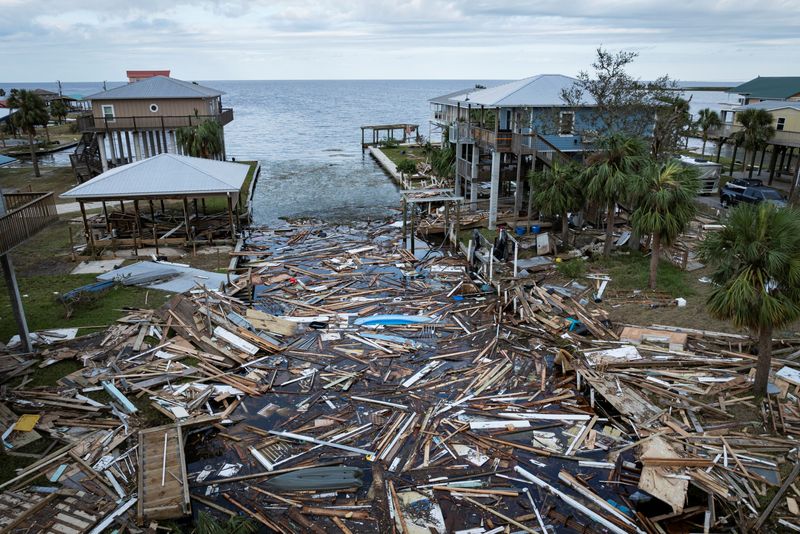By Rich McKay, Joseph Ax and Andrew Hay
ATLANTA (Reuters) -Authorities across a wide swath of the southeastern United States faced the daunting task on Saturday of cleaning up from Hurricane Helene, one of the most powerful to hit the country, as the death toll continued to rise.
At least 47 deaths were reported by early Saturday, and officials feared still more bodies would be discovered across several states.
Downgraded late on Friday to a post-tropical cyclone, Helene continued to produce heavy rains across several states, sparking life-threatening flooding that threatened to create dam failures that could inundate entire towns.
In Florida’s Pinellas County near Tampa, Sheriff Bob Gualtieri said he had never seen destruction like what was wrought by Helene. “I would just describe it, having spent the last few hours out there, as a war zone,” Gualtieri told a press conference.
At least 3.25 million customers woke up early on Saturday without power across five states, with authorities warning it could be several days before services were fully restored. The worst outages were in South Carolina with more than 1 million homes and businesses without power, and Georgia with 777,000 without power.
As of 11 a.m. the remnants of the storm was about 145 miles (235 km) southwest of Louisville, Kentucky.
Some of the worst rains hit western North Carolina, which saw almost 30 inches (76 cm) of precipitation fall on Mount Mitchell in Yancey County, the NWS’s Weather Prediction Center reported.
Atlanta was hit with 13 inches of rain, and in South Georgia farmers were assessing the damages to the state’s $1 billion cotton crop now in its harvest season.
Scientists say climate change contributes to fueling stronger, more destructive hurricanes.
Before moving north through Georgia and into Tennessee and the Carolinas, Helene hit Florida’s Big Bend region as a powerful Category 4 hurricane on Thursday night, packing 140 mph (225 kph) winds. It left behind a chaotic landscape of overturned boats in harbors, felled trees, submerged cars and flooded streets.
Police and firefighters carried out thousands of water rescues throughout the affected states on Friday.
More than 50 people were rescued from the roof of a hospital in Unicoi County, Tennessee, about 120 miles (200 km) northeast of Knoxville, state officials said, after flood waters swamped the rural community.
Rising waters from the Nolichucky River prevented ambulances and emergency vehicles from rescuing patients and others there, the Unicoi County Emergency Management Agency said on social media. Emergency crews in boats and helicopters were used to conduct rescues.
Elsewhere in Tennessee, Rob Mathis, the mayor of Cocke County, ordered the evacuation of downtown Newport because of a potential failure at the nearby Walters dam.
The National Weather Service issued flash flood warnings overnight for a swath of eastern Tennessee covering 100,000 residents, warning them to seek higher ground. The Nolichucky Dam in Tennessee’s Greene County was on the brink of failure early on Saturday, officials reported, adding that a breach could occur at any time.
On Friday, President Joe Biden added Tennessee to the long list of states under declarations of emergency, which frees up federal funds and other assistance for recovery.
In western North Carolina, Rutherford County emergency officials warned residents near the Lake Lure Dam that it might fail, although they said late on Friday that failure did not appear imminent.
Multiple people in and around Chimney Rock, North Carolina, described the downtown as washed out, with images online showing inches of mud and sediment, uprooted trees and snapped telephone poles and building torn to debris.
“All right folks, listen up, Chimney Rock is gone, Flowering Bridge is gone,” said poster Touristpov on TikTok, showing videos of the destruction. “I don’t know what they’ll do to get us out of here.”
In nearby Buncombe County, landslides forced interstate highways 40 and 26 to close and parts of the highways were washed out, the county said on X.
WAKING TO DISASTER
The extent of the damage in Florida began emerging after daybreak on Friday.
In coastal Steinhatchee, a storm surge – a wall of seawater pushed ashore by winds – of eight to 10 feet (2.4-3 meters) moved mobile homes, the National Weather Service said on X. In Treasure Island, a barrier island community in Pinellas County, boats were grounded in front yards.
The city of Tampa posted on X that emergency personnel had completed 78 water rescues of residents and that many roads were impassable because of flooding. The Pasco County sheriff’s office rescued more than 65 people.
A total of 11 people died in Florida, Governor Ron DeSantis said on Saturday, speaking in Perry, Florida, which saw 15-foot storm surges, larger than hurricanes in recent years.
“If you look around here, you can see that some homes are just rubble,” he said. “This stuff comes in, it’s fierce and it’s just unstoppable.”
Deanne Criswell, director of the Federal Emergency Management Agency, joined DeSantis on Saturday touring storm damaged areas of the state.
“I just want to say on behalf of the president that we extend our deepest sympathies for those families that have lost loved ones,” Criswell said.

Georgia Governor Brian Kemp’s office reported 15 storm-related fatalities in that state, while North Carolina Governor Roy Cooper said there had been two deaths there.
At least 19 people died during the storm across South Carolina, the Charleston-based Post and Courier newspaper reported, citing local officials.